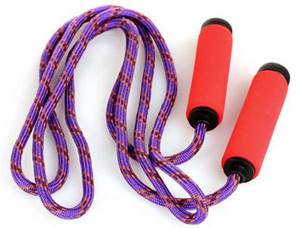Jumping rope is one of the simplest and most accessible means for developing most physical indicators of the body: endurance, coordination, anaerobic endurance, explosive strength. All these features help the athlete reach a new level, and just fitness enthusiasts - get into excellent physical shape, improving their health. Let's take a closer look at the reasons why the benefits of jumping rope are simply undeniable.
Jumping rope - the essence of the exercise and its effect on the body
As mentioned above, you are mistaken if you think that jumping is just useless children's fun. This exercise is definitely included in a good cardio training program, as it perfectly loads all muscle groups , strengthens the cardiovascular system and burns a crazy amount of calories.
A jump rope will be an excellent solution for people who, for some reason, cannot do a full workout or go for a run. In addition, jumping rope will be extremely useful for those who want to lose weight or shape their figure.
Neuro jump rope tricks
If you jump to the rhythm of music, the right hemisphere will develop. And if you count to yourself for each circle or say a tongue twister, the left hemisphere develops. Although the neuro-jumping rope appeared quite recently, in Russia there is already a real record holder for performing tricks with it. A boy from Novosibirsk, Popov Spartak, is able to complete 100 jumps in just one minute. The child is only 6 years old.
Neuro-jumping rope can captivate both children and adults. Especially if they are used to achieving their goals. For a family with children and active parents, it makes sense to buy several of these devices.
The benefits of jumping rope
Let's take a closer look at the impact of this exercise and its advantages:
- It has already been said that jumping rope is extremely useful for those who want to get rid of extra pounds, and here's why - jumping is one of the most energy-consuming exercises . In half an hour of jumping you can burn three hundred to four hundred calories, and in an hour - eight hundred or even more! For reference: in one hour of jogging outside, you will burn no more than five hundred calories.
- A nice bonus is that this exercise is accessible to almost everyone . Buying a jump rope will not be difficult, and you can practice jumping not only in the gym, but also at home. Thus, this exercise is not only effective, but also very budget-friendly.
- Jumping perfectly trains all the muscles in our body . A colossal load is placed on the entire muscular body, and in particular on the legs and buttocks. A jump rope will help get rid of problems such as riding breeches (“ears” on the hips) and fat on the inner thigh. Jumping jumps are also effective in combating a plump and flabby belly and can tone weak calf muscles.
- Raising your hips while jumping will perfectly strengthen your buttocks and stomach .
- Cardio exercises, which include jumping, are excellent for training the cardiovascular system . Regular cardio training significantly strengthens the heart and improves its function, normalizes blood pressure and, of course, prevents many heart diseases.
- Jumping is an effective workout for our respiratory system. Regular exercise improves the condition of the lungs , increases their volume, and actively saturates all tissues and organs with oxygen.
- This type of load also strengthens the musculoskeletal system: the spine and joints.
- Jumping perfectly trains endurance and strength .
- To get the maximum effect from jumping rope, also include running in your training.
- Jumping rope has a positive effect on coordination of movements. Body flexibility is significantly improved.
- It is also worth noting the fact that during any workout (including cardio), the “hormone of happiness” is released in the human body - endorphin . This leads to an uplift in mood, which means it is an excellent tool in the fight against depression, anxiety and despondency.
Length, material of the rope and handles - how to choose a rope?

Unlike most sports equipment, a jump rope must be selected individually. And the point is not at all in personal preferences, but in such moments as the size and weight of the jump rope suitable for a person, the material of the cord and handles itself, and much more.
Attention ! An incorrectly selected jump rope makes training difficult, which can lead to injury.
Cord length
The length of the rope is selected based on the height of the person who plans to skip. The classic way to find out if a jump rope is suitable for a person's height is to stand in the middle of the cord with your feet and lift the handles up so that the cord is straight. If the top of the handles reaches the armpits, the jump rope is perfect. If they are lower, the rope is short; if they are higher, it is too long.
Ideally, the rope can be adjusted in length. Then it can be used by several people. This opportunity will especially appeal to families in which several people lead an active lifestyle and plan to exercise through skipping.
Cord material
The first thing you should pay attention to is the material from which the jump rope cord is made. The most popular and widespread option is polyvinyl chloride. Such jump ropes have good elasticity, density and flexibility, which allows them to be used for intensive training by both beginning “jumpers” and professional athletes.
Slightly less popular are jump ropes made of rubber, cotton and nylon. They have good flexibility and do not tangle. However, they are not strong and heavy enough, so they are often purchased for children. The main advantage of jump ropes made of PVC, rubber, nylon and cotton is the ability to adjust the length of the cord. This allows people of different heights to use sports equipment.
The least common are leather and metal jump ropes, which are distinguished by their high cord weight and good ability to cut through the air. Such sports equipment is used only by professional athletes, since they do not have length adjustment, and therefore they are purchased taking into account the individual characteristics of one person.
Feel free to try the jump rope right in the store to evaluate its convenience and ergonomics. In this case, you can evaluate such an indicator as the weight of a sports equipment. If the rope seems too light, feel free to choose a heavier option, but without fanaticism - too much weight will lead to rapid arm fatigue, which will cause the workout to go down the drain.
Handle material
Handles are no less important than the cord, an element of the jump rope. Very often they are made of plastic. Such handles are smooth and light, but they also have a significant drawback - during training, your palms almost instantly become wet, and the rope slips out of your hands. To prevent this from happening, it is recommended to give preference to the following materials:
- wood - handles made from it are lightweight and durable, they do not heat up and allow the skin
- keep your palms dry;
- neoprene is an ideal material for handles, as it absorbs moisture, does not slip out of your hands, and always remains cool;
- metal, sometimes with rubber pads - these handles are too heavy for beginners, but are ideal for professional athletes who want to strengthen the forearm and hands.
In addition to the material, you need to pay attention to the quality of the surface of the handles and their ergonomics. They should lie as naturally as possible in the hand and not put pressure on the protruding parts of the palms.
The handles should not have burrs, cracks or roughness - even a short workout with them will result in the formation of painful calluses.
Contraindications and possible harm
Alas, this exercise, like any load, has certain contraindications, which you can read about below:
- First of all, it is worth saying that jumping is prohibited for people who have serious problems with the cardiovascular system (heart failure, heart disease, previous heart attack, and problems with blood pressure).
- Jumping rope can be harmful for overweight people, since this type of load has a destructive effect on the knee joints.
- Vascular diseases (for example, varicose veins) are also a contraindication to sports.
- Jumping is not recommended for persons with musculoskeletal problems (osteochondrosis, arthritis, existing hernia).
- As for the harm from the exercise, it is worth considering that jumping rope can overtrain the calf muscles and make them too noticeable. This is especially worth keeping in mind for girls.

Precautionary measures
In order for jumping rope to benefit your health and beauty, you must follow simple recommendations:
- don’t forget to warm up before training and choose a jump rope according to your height;
- do not jump barefoot to avoid accidental injury to your feet;
- It is important for women to choose the right equipment that will support their breasts well during jumping;
- if classes are held at home, then you should not jump on the bare floor, choose a comfortable mat that softens the jumps;
- when landing, lower yourself onto the front of your feet, do not land on your heels or your entire foot;
- keep your legs slightly bent at the knees, practice fast and high jumps;
- Do not exercise in clothes that are too loose, in the edges of which the jump rope may get tangled.

Recommendations
Let's talk about how to start and then diversify your training with a jump rope and make it more effective:
- If you are a beginner and have never exercised before, start with three to five minutes of jumping jacks a day . This will allow your body to get used to the load and avoid unnecessary fatigue. In addition, you will learn the correct technique for performing the exercise.
- Increase the duration of the jumps after you can easily endure five minutes of jumping rope. Gradually increase the training time: from five minutes to ten, from ten to fifteen, and so on until you learn to jump without a break for thirty minutes. Please note: to reach this level, you will need at least a month of regular training.
- Jump rope training can be varied with the following elements: interrupt jumping for running (for a couple of minutes) or walking (for one to two minutes).
- Don't forget to warm up and warm up your muscles before jumping.
- Perform jumps only in comfortable sports shoes! This measure will greatly reduce the risk of injury during training.
- Be sure to drink water during exercise to help prevent dehydration.

Monthly training program
As we have already said, the energy consumption during exercise with a jump rope is phenomenal. If you consider that for a smooth, systematic weight loss, a deficit of 250-350 calories per day is enough, then regularly doing jumping rope will allow you not to be too hungry while losing weight. Just regular training is enough.
You don't have to make any major changes to your diet—consume only the amount of nutrients you need to maintain your weight. For women, you should consume about 1600-1800 calories, for men - 2200-2400. This is your approximate norm for maintaining weight (excluding calories burned during training).
One gram of fat contains about 9 calories. Using simple calculations, we calculate that to get rid of one kilogram of excess fat (namely fat, not muscle) you need to spend 9,000 calories. Such a deficit can easily be created by choosing jumping rope as your main physical activity. In this situation, you can easily lose 1-1.5 kg of weight per week. Only fat will be consumed, loss in muscle mass will be minimal.
Another obvious benefit from training with a jump rope is the development of anaerobic endurance. This is a key skill for any CrossFit athlete. Without anaerobic endurance, you will not be able to show decent results in any more or less advanced complex - you may have enough strength for this, but the lack of proper breathing will not allow you to complete it in the minimum time.
In CrossFit, the one who is simply stronger rarely wins. All-round development of the body is needed here. That is why it makes sense for both amateurs and professionals to do a separate cardio workout during the week. As part of it, we do not perform any functional complexes. We only do cardio. And if your goal is serious results in CrossFit, then it is best to choose a jump rope for this workout.
The workout should not be too hard, we work at an average pace. Duration – 60-90 minutes. Among other things, this is a great way to take a little break from hard training with iron and relieve your psyche.
Beginner jumpers are recommended to perform exercises at a speed of 100 jumps per minute. At the same time, in 1 month, do not exceed the training time of 40-60 minutes. It is necessary to combine different types of exercises within 1 workout: on one leg, crossover, offset, etc.
The program for the 1st month could be like this:
- Days 1-5. 5 minutes of jumping on 2 feet at a slow pace to warm up the muscles and allow the body to get used to the load. Then 2 minutes on the left and right limbs alternately. And 20 more exercises with shifts to the left and to the right. We complete the workout with 5 minutes at a comfortable pace on 2 legs.
- Days 5-15. 5 minutes at low speed. Then 3 minutes on each foot, 30 exercises to the right and left. We rest for 3 minutes, doing squats or jogging. Again 5 minutes at an average pace. 20 movements forward and backward, then in place, but with the body turning in one direction or the other. These exercises engage your abs. 10 each with high knees and, finally, 5 minutes at low speed.
- On days 8, 16, 22 and 31, you need to schedule a break from training to give your muscles time to grow.
- Days 15-30. We start, according to tradition, with warming up for 5 minutes. We increase the speed by counting approximately 100 movements. Slow down the pace, alternate legs, as in the previous paragraph. 10 minutes we jump right - left, forward - back. 3 minutes of rest followed by other exercises. 10 minutes at an average pace, then another 100 jumps with acceleration. 50 movements each with a turn left and right. Then do 20 knee raises and finish with a 10-minute slowdown.
After 2-3 weeks of regular exercise, results will be visible.
Main types of jumps
The rope should be held at the line of the hips or waist. The hands should be directed towards the body. You should start jumping with a slight bend in your knees, but jumping should be done by cushioning your feet.
The back should be straightened and the abdominal muscles tense. There is no need to try to take the greatest height. Jumping up to 4 centimeters in height will be enough.
- Jumping in turns
Using the above technique, you should jump in turns, now on one leg, now on the other. This exercise helps develop coordination.
- Combined jumps
This jumping technique consists of alternating basic and alternate exercises. This is done according to the following scheme: left leg-two legs-right leg-two legs.
- High jumps
The technique is similar to alternate jumps. Only when your left foot touches the ground should you raise your right knee high.
High jumps are a very intense load.
By combining all these exercises you can create an effective fifteen-minute workout.
How long to jump?
effective training
Start with feasible loads at a calm pace. The body adapts, and the muscles and joints have time to get stronger.
Increase the load gradually. The first week we jump for 5-10 minutes once a day or every other day,
pausing 30 seconds between sets to stretch, swing, bend, and twist.
Every next week we add 10-15 minutes, thus bringing the duration of the workout to an hour (with 3-minute breaks for less intense exercises).
It is good to alternate jumping forward on two legs with jumping backward and jumping alternately on each leg.
(2 minutes on one, next set - 2 minutes on the other).
It is best to jump to fast, energetic music.
The main exercise is jumping on two legs while twisting the rope forward. To use the maximum number of muscles, alternate different types of jumps (there are about 30 of them). On two legs; landing on each leg in turn; on one leg; jumping from side to side; with knees raised high; turning the rope forward; back; cross. In the high-impact series, don’t forget about double jumps.










